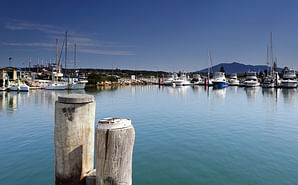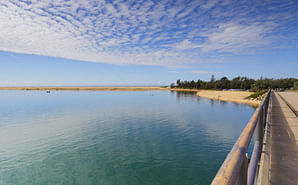Regional priority weeds
Some local control authorities have local control programs covering priority species for their area under Section 371 of the Biosecurity Act 2015.
Some local control authorities have local control programs covering priority species for their area under Section 371 of the Biosecurity Act 2015. In addition to consulting the regional plan, it is important to check with your council if there are any local programs in place for your local government area. If a plant is not recognised in the regional plan or in a local program, then it may be dealt with under a general biosecurity duty. Species that are outside of the scope of a plan or program should be assessed in terms of risk, context and situation before general biosecurity duty is applied.
On this page you will find information about:
Regional priority weed category – PREVENTION (whole of region)
The following weeds are currently not found in the region, pose significant biosecurity risk and prevention of the biosecurity risk posed by these weeds is a reasonably practical objective.
- Sickle thorn – Asparagus falcatus
- Coral creeper – Barleria repens
- Kidney leaf mud plantain – Heteranthera reniformis
- Water star grass – Heteranthera zosterifolia
- Holly leaved senecio – Senecio glastifolius
Outcomes to demonstrate compliance with general biosecurity duty
- Land managers should mitigate the risk of the plant being introduced to their land
- Land managers should eradicate the plant from the land and keep the land free of the plant
- A person should not deal with the plant, where dealings include but are not limited to buying, selling, growing, moving, carrying or releasing the plant
- Notify local control authority if found.
Strategic response in the South East region
- Identify high risk sites and pathways and conduct ongoing surveillance for incursions of the species.
- Prevention of entry to geographic area, and movement and sale within. Have a collaborative rapid response protocol in place.
- Implement site specific biosecurity and / or hygiene protocols.
State priority weed category – ERADICATION (whole of region)
The following weeds pose a medium to high biosecurity risk to NSW and vary in distribution and abundance in different parts of the state. The principal object of a biosecurity zone regulation is to provide for the long term management of a biosecurity risk or biosecurity impact.
- Ming asparagus fern/pompom asparagus – Asparagus macowanii var. zuluensis
- Groundsel bush – Baccharis halimifolia
- Cat’s claw creeper – Dolichandra unguis-cati (syn. Macfadyena unguis-cati) *
- Kei apple – Dovyalis caffra
- Horsetails – Equisetum spp.
- Senegal tea plant – Gymnocoronis spilanthoides
- Water poppy – Hydrocleys nymphoides
- Long leaf water primrose – Ludwigia longifolia
- Ludwigia – Ludwigia peruviana
- Water lettuce – Pistia stratiotes
- Kudzu – Pueraria lobata
- Salvinia – Salvinia molesta
- Giant devil’s fig – Solanum chrysotrichum
- Silverleaf nightshade – Solanum elaeagnifolium
- Sticky nightshade – Solanum sisymbriifolium
Outcomes to demonstrate compliance with general biosecurity duty
- Land managers should mitigate the risk of the plant being introduced to their land
- Land managers should eradicate the plant from the land and keep the land free of the plant
- A person should not deal with the plant, where dealings include but are not limited to buying, selling, growing, keeping, moving, carrying or releasing the plant.
- Notify local control authority if found.
Strategic response in the South East region
- Establish agreed quarantine and/or hygiene protocols Surveillance and mapping to locate all infested properties Destruction of all infestations including seed banks
- Prevention of entry to geographic area, and movement and sale within Monitor progress towards eradication
- Undertake high risk sites and pathway inspections.
Regional priority weed category – CONTAINMENT
These weeds are widely distributed in some areas of the state. As Weeds of National Significance, their further spread through trade should be minimised to protect priority assets.
- Mysore thorn – Caesalpinia decapetala
Land area where requirements apply
- Containment zone: Wollongong Local Government Area.
- Exclusion zone: Whole of region except containment zone.
Outcomes to demonstrate compliance with general biosecurity duty
Whole of region:
- Land managers mitigate the risk of new weeds being introduced to their land
- A person should not deal with the plant, where dealings include but are not limited to buying, selling, growing, moving, carrying or releasing the plant.
Within exclusion zone:
- Land managers should eradicate the plant from the land and keep the land free of the plant
- Notify local control authority if found.
Within containment zone:
- Land managers should reduce the impact of the plant on assets of high economic, environmental and/or social value
- Land managers should mitigate spread of the plant from their land.
Strategic response in the South East region
Within exclusion zone:
- Establish agreed quarantine and/or hygiene protocols.
- Surveillance and mapping to locate all infested properties and maintain currency of exclusion zone and objectives.
- Monitor change in current distribution to ensure containment of spread.
- High level analysis of pathways to identify potential introduction areas and preventative options
Within containment zone:
- Identification of key sites/ assets in the geographic area Identification of regional containment zones where required
- Develop region-wide coordinated campaigns for collaborative management Species managed in accordance with published weed management plan
- Spanish heath – Erica lusitanica
Land area where requirements apply
- Containment zone: Queanbeyan- Palerang, Snowy Monaro and Wingecarribee Local Government Areas.
- Exclusion zone: Whole of region except containment zone.
Outcomes to demonstrate compliance with general biosecurity duty
Whole of region:
- Land managers mitigate the risk of new weeds being introduced to their land
- A person should not deal with the plant, where dealings include but are not limited to buying, selling, growing, moving, carrying or releasing the plant.
Within exclusion zone:
- Land managers should eradicate the plant from the land and keep the land free of the plant
- Notify local control authority if found.
Within containment zone:
- Land managers should reduce the impact of the plant on assets of high economic, environmental and/or social value
- Land managers should mitigate spread of the plant from their land.
Strategic response in the South East region
Within exclusion zone:
- Establish agreed quarantine and/or hygiene protocols.
- Surveillance and mapping to locate all infested properties and maintain currency of exclusion zone and objectives.
- Monitor change in current distribution to ensure containment of spread.
- High level analysis of pathways to identify potential introduction areas and preventative options
Within containment zone:
- Identification of key sites/ assets in the geographic area Identification of regional containment zones where required
- Develop region-wide coordinated campaigns for collaborative management Species managed in accordance with published weed management plan
- Coolatai grass – Hyparrhenia hirta
Land area where requirements apply
- Containment zone: Goulburn Mulwaree, Shoalhaven, Snowy Monaro, Wingecarribee, Upper Lachlan, Wollongong and Shellharbour Local Government Areas.
- Exclusion zone: Whole of region except containment zone.
Outcomes to demonstrate compliance with general biosecurity duty
Whole of region:
- Land managers mitigate the risk of new weeds being introduced to their land
- A person should not deal with the plant, where dealings include but are not limited to buying, selling, growing, moving, carrying or releasing the plant.
Within exclusion zone:
- Land managers should eradicate the plant from the land and keep the land free of the plant
- Notify local control authority if found.
Within containment zone:
- Land managers should reduce the impact of the plant on assets of high economic, environmental and/or social value
- Land managers should mitigate spread of the plant from their land.
Strategic response in the South East region
Within exclusion zone:
- Establish agreed quarantine and/or hygiene protocols.
- Surveillance and mapping to locate all infested properties and maintain currency of exclusion zone and objectives.
- Monitor change in current distribution to ensure containment of spread.
- High level analysis of pathways to identify potential introduction areas and preventative options
Within containment zone:
- Identification of key sites/ assets in the geographic area Identification of regional containment zones where required
- Develop region-wide coordinated campaigns for collaborative management Species managed in accordance with published weed management plan
- Lantana – Lantana camara
Land area where requirements apply
- Containment zone: Eurobodalla, Shoalhaven, Wollongong, Shellharbour and Kiama Local Government Areas.
- Exclusion zone: Whole of region except containment zone.
Outcomes to demonstrate compliance with general biosecurity duty
Whole of region:
- Land managers mitigate the risk of new weeds being introduced to their land
- A person should not deal with the plant, where dealings include but are not limited to buying, selling, growing, moving, carrying or releasing the plant.
Within exclusion zone:
- Land managers should eradicate the plant from the land and keep the land free of the plant
- Notify local control authority if found.
Within containment zone:
- Land managers should reduce the impact of the plant on assets of high economic, environmental and/or social value
- Land managers should mitigate spread of the plant from their land.
Strategic response in the South East region
Within exclusion zone:
- Establish agreed quarantine and/or hygiene protocols.
- Surveillance and mapping to locate all infested properties and maintain currency of exclusion zone and objectives.
- Monitor change in current distribution to ensure containment of spread.
- High level analysis of pathways to identify potential introduction areas and preventative options
Within containment zone:
- Identification of key sites/ assets in the geographic area Identification of regional containment zones where required
- Develop region-wide coordinated campaigns for collaborative management Species managed in accordance with published weed management plan
- Gorse – Ulex europaeus
Land area where requirements apply
- Containment zone: Goulburn Mulwaree, Queanbeyan-Palerang, Snowy Monaro, Wingecarribee and Yass Valley Local Government Areas.
- Exclusion zone: Whole of region except containment zone.
Outcomes to demonstrate compliance with general biosecurity duty
Whole of region:
- Land managers mitigate the risk of new weeds being introduced to their land
- A person should not deal with the plant, where dealings include but are not limited to buying, selling, growing, moving, carrying or releasing the plant.
Within exclusion zone:
- Land managers should eradicate the plant from the land and keep the land free of the plant
- Notify local control authority if found.
Within containment zone:
- Land managers should reduce the impact of the plant on assets of high economic, environmental and/or social value
- Land managers should mitigate spread of the plant from their land.
Strategic response in the South East region
Within exclusion zone:
- Establish agreed quarantine and/or hygiene protocols.
- Surveillance and mapping to locate all infested properties and maintain currency of exclusion zone and objectives.
- Monitor change in current distribution to ensure containment of spread.
- High level analysis of pathways to identify potential introduction areas and preventative options
Within containment zone:
- Identification of key sites/ assets in the geographic area Identification of regional containment zones where required
- Develop region-wide coordinated campaigns for collaborative management Species managed in accordance with published weed management plan
- Sea Spurge – Euphorbia paralias
Land area where requirements apply
- Exclusion zone: Wollongong, Shellharbour and Kiama Local Government Areas.
Outcomes to demonstrate compliance with general biosecurity duty
Whole of region:
- Land managers mitigate the risk of new weeds being introduced to their land
- A person should not deal with the plant, where dealings include but are not limited to buying, selling, growing, moving, carrying or releasing the plant.
Within exclusion zone:
- Land managers should eradicate the plant from the land and keep the land free of the plant
- Notify local control authority if found.
Within containment zone:
- Land managers should reduce the impact of the plant on assets of high economic, environmental and/or social value
- Land managers should mitigate spread of the plant from their land.
Strategic response in the South East region
Within exclusion zone:
- Establish agreed quarantine and/or hygiene protocols.
- Surveillance and mapping to locate all infested properties and maintain currency of exclusion zone and objectives.
- Monitor change in current distribution to ensure containment of spread.
- High level analysis of pathways to identify potential introduction areas and preventative options
Within containment zone:
- Identification of key sites/ assets in the geographic area Identification of regional containment zones where required
- Develop region-wide coordinated campaigns for collaborative management Species managed in accordance with published weed management plan






Was this helpful?